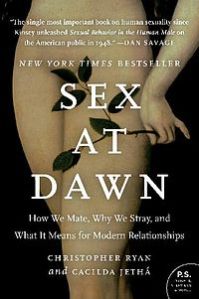The ancestral health lifestyle starts with the fact that our species evolved under a set of conditions as hunter-gatherers for a more substantial period of time than our relatively short period spent as farmers. Therefore, this approach hypothesizes, we are likely better adapted to the former conditions and should mimic aspects of those conditions to optimize health. For diet, this means eating less grains and sugar, and more vegetables, meat, and fruit. It means moving our bodies, spending time outside, and playing. But what does it mean for sex?
 The topic of sexual health seems particularly appropriate here given this blog’s focus on cultural barriers to healthy living and the intense role culture plays in our sex lives. We are scarcely aware of how deeply our culture affects our sexuality until we are exposed to cultures that treat sexuality radically differently.
The topic of sexual health seems particularly appropriate here given this blog’s focus on cultural barriers to healthy living and the intense role culture plays in our sex lives. We are scarcely aware of how deeply our culture affects our sexuality until we are exposed to cultures that treat sexuality radically differently.
I recently discovered a book that applies an ancestral health lens to human sexuality, surveying sexuality in hunter-gatherer societies and examining how those origins manifest themselves in modern sexuality. Sex at Dawn will open your eyes to a lot of mistaken assumptions we have about what a natural/normal/healthy sex life is. However, it doesn’t lead to any clear answers other than having an open mind about choices and trade-offs people make about how to live their lives.
At the roots of our cultural practices around sex are patrimony – our understanding of who the father of each child is – and patriarchy – the passing down of property from father to son. We men need to know who our children are so we can devote our resources to them, so we control female sexuality through shame (or through force in the past).
Hunter gatherer societies had a different understanding of patrimony where children could have multiple fathers, and even multiple mothers (through breastfeeding), and no property to pass between generations, let alone a patriarchal system. Hunter-gatherers lived in fiercely egalitarian bands of about 100 people where polyamory was the norm and expression of jealousy toward a mate’s other lovers was frowned upon. Sex was more an activity that enhanced bonds within the band than a means of procreation – although it obviously accomplished that as well.
In the book, authors Christopher Ryan and Cacilda Jetha first dismantle the Hobbesian conventional wisdom that hunter-gatherers’ lives were “solitary, poor, nasty, brutish and short.” It turns out they actually had it pretty good. While infant survival was horrid, if they survived to age 5, our hunter-gatherer ancestors lived long healthy lives with plenty of food most of the time, loving relationships, lots of leisure time and lots of sex with multiple partners – sex which served to bind members of the band together.
The book runs through the evidence supporting this perspective: observations of extant hunter-gatherers, the shape of the human penis, female copulatory vocalizations, human copulation frequency, lack of human female fertility signals, sexual behavior of bonobos and chimpanzees, and modern human sexual behavior. Read the book if you want details on how these pieces of the puzzle all fit together to support their hypothesis. It’s an engaging read.
With our modern understanding of patrimony, we have partaken of the tree of knowledge and can’t go back to a time when a kid could have multiple biological fathers. So in the end, Sex at Dawn does little to offer sex-life advice for us to better meet our needs and desires other than awareness of these “prehistoric origins of modern sexuality,” open minds about polyamory and other non-hetero-monogamous approaches to sex, and ammunition to push back against shaming of consensual sexual practices.
The anti-Hobbesian picture of our hunter-gatherer ancestors painted in Sex at Dawn brings up issues I’m excited to write about: child-rearing in a nuclear family, and political influence of the ultra-wealthy. I also plan to post soon about another book that offers some sex-life solutions for a substantial subset of us – a path toward resisting shame and patriarchy in heterosexual relationships for better sex and a better world.
Have you read Sex at Dawn and have thoughts, or can you recommend other books on sexuality or family structure?
